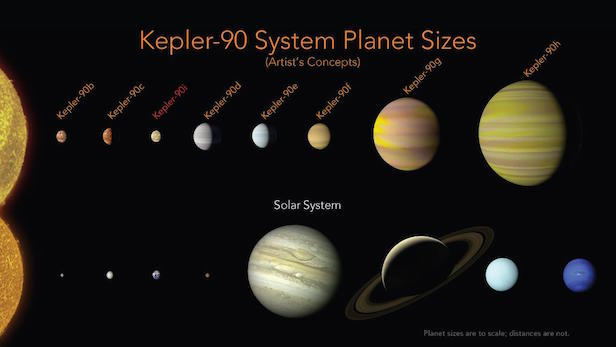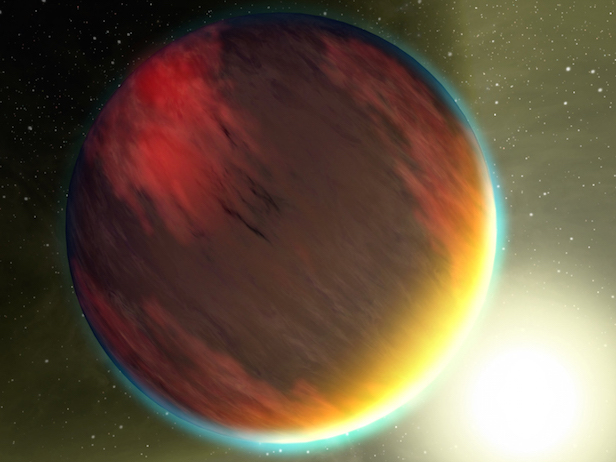Google-led artificial intelligence reveals Solar System isn’t unique
A new world has been found, bumping the Kepler-90 system up to eight planets

The Kepler-90 planetary system now matches our Solar System for the number of planets within the system. Image credit: NASA/Ames Research Centre/W. Stenzel
Our Solar System is no longer the frontrunner for the ‘most number of planets orbiting a single star’. This comes after news that Google-led artificial intelligence discovered a new world around the star Kepler-90, 2,545 light years from Earth. The eighth planet was found amongst the vast data collected by NASA’s Kepler spacecraft.
The recently discovered exoplanet – a planet outside of our Solar System – Kepler-90i, is a rocky planet that is roasted due to the close proximity to its host star, completing one orbiting every 14.4 days. This planet was discovered in an unusual and impressive fashion, as it was found by using a machine learning approach created by Google. As the Kepler data set is so massive, the tech giant put this technique to the test by searching for changes in starlight caused by planets passing in front of their stars.
“Just as we expected, there are exciting discoveries lurking in our archived Kepler data, waiting for the right tool or technology to unearth them,” says Paul Hertz, director of NASA’s Astrophysics Division in Washington. “This finding shows that our data will be a treasure trove available to innovative researchers for years to come.”
Christopher Shallue and Andrew Vanderburg developed this technological technique, where they trained a computer to identify alien worlds from the light readings of stars gathered by Kepler. This occurs when an exoplanet passes in front of its host star, blocking out some of the light and creating a dip in the light readings – also known as a ‘transit’. Inspired by how neurons connect in the human brain, this artificial “neural network” went through the Kepler data trying to find the weakest transit signals possible. This is what led to the discovery of Kepler-90i in the constellation of Draco.
This technique can be used for other, more promising exoplanets candidates. This is because Kepler-90i is roughly 30 percent larger than Earth, and sits so close to the star that it’s surface is heated to at least 430 degrees Celsius (800 degrees Fahrenheit). This is equivalent to the surface temperature of Mercury. The outermost exoplanets in the system, Kepler-90h, orbits its star at a distance similar to Earth from the Sun.
“The Kepler-90 star system is like a mini version of our Solar System. You have small planets inside and big planets outside, but everything is scrunched in much closer,” says Vanderburg, a NASA Sagan Postdoctoral Fellow and astronomer at the University of Texas at Austin.

Kepler has discovered over 2,500 exoplanets and has over 5,000 exoplanet candidates. Image credit: NASA/JPL-Caltech/T. Pyle (SSC)
Shallue, a senior software engineer with Google’s research team Google AI, had the revelation to apply this neural network to the Kepler data. This idea came about from his initial interest in exoplanet discoveries, and then he realised that the rate of data collection is beyond the rate of analysing it.
“In my spare time, I started Googling for ‘finding exoplanets with large data sets’ and found out about the Kepler mission and the huge data set available,” says Shallue. “Machine learning really shines in situations where there is so much data that humans can’t search it for themselves.”
Kepler’s four-year dataset consists of 35,000 possible planetary signals. To sift through this originally, astronomers used automated tests along with the keen human eye, to verify the presence of exoplanets. Unfortunately, the weakest signals can be missed. Shallue and Vanderburg thought there could be even more exhilarating exoplanets discoveries hidden within this wide dataset.
To begin with, the neural network was trained to identify exoplanets from a set of 15,000 previously investigated targets from the Kepler exoplanets catalogue. This test led to the neural network correctly identifying true planets and false positives 96 percent of the time. Once the network “learned” how to identify exoplanets signals, it was then redirected to the weaker signals of 670 other star systems that have previously known exoplanets. The idea behind this was that if there are already exoplanets there, there could be even more!
“We got lots of false positives of planets, but also potentially more real planets,” said Vanderburg. “It’s like sifting through rocks to find jewels. If you have a finer sieve then you will catch more rocks but you might catch more jewels, as well.”
Shallue and Vanderburg plan to apply this successful neural network to Kepler’s full data set, which consist of more than 150,000 stars. This data set came from staring at one patch of the sky was four years, but he spacecraft now is operating as an extended mission that switches its field of view every 80 days.
Keep up to date with the latest reviews in All About Space – available every month for just £4.99. Alternatively you can subscribe here and make the most of our Christmas offer for a fraction of the price!




